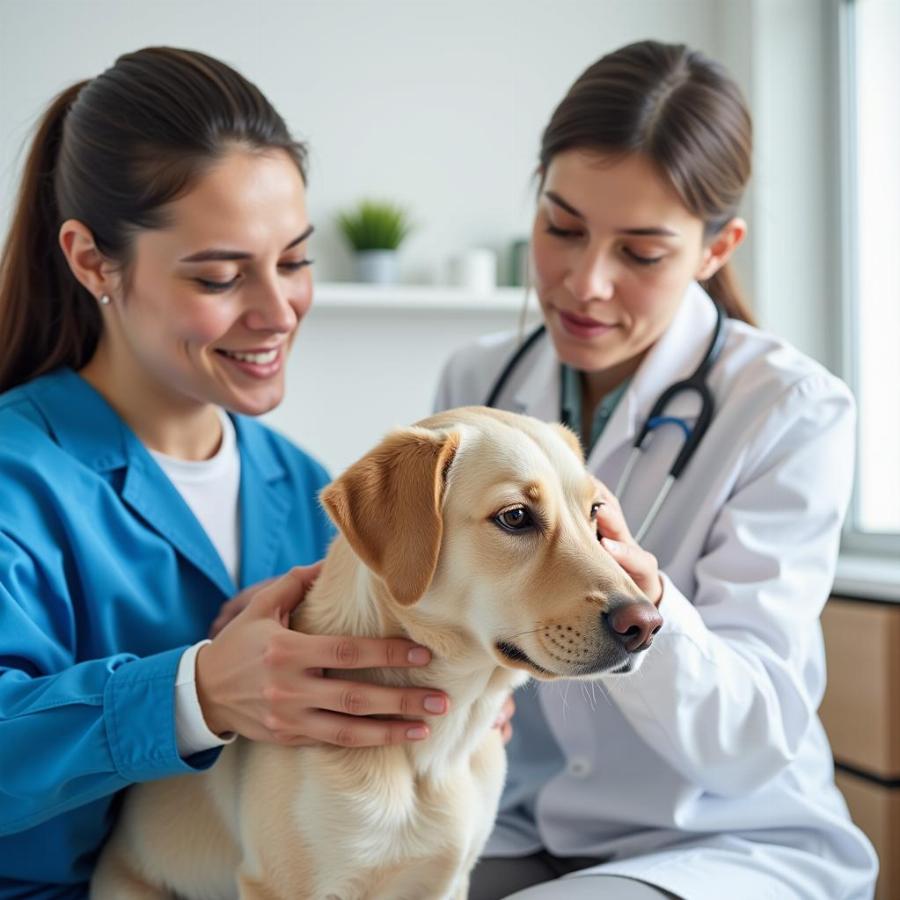Keeping your canine companion safe and healthy is a top priority for every dog owner. One crucial aspect of dog care is understanding which foods are toxic to dogs and can pose serious health risks. While we often share our food with our furry friends, many seemingly harmless human foods can be incredibly dangerous for dogs, even in small amounts. This article will explore the most common and dangerous foods that are toxic to dogs, helping you make informed decisions about their diet and prevent accidental poisoning.
Knowing What Foods Are Most Toxic To Dogs is crucial for responsible pet ownership. Foods that are perfectly safe for humans can cause a range of health problems in dogs, from mild digestive upset to severe organ damage and even death. Understanding the potential dangers and taking preventative measures can protect your furry friend from harm. This comprehensive guide will help you navigate the complexities of canine nutrition and identify the foods you should absolutely avoid giving your dog.
Common Foods Toxic to Dogs
Several everyday foods can be hazardous to your dog’s health. Here are some of the most common culprits:
-
Chocolate: All types of chocolate, especially dark chocolate and baking chocolate, contain theobromine, a compound that dogs metabolize much slower than humans. This can lead to vomiting, diarrhea, increased thirst, panting, excessive urination, hyperactivity, abnormal heart rhythm, tremors, seizures, and even death.
-
Xylitol: This artificial sweetener found in many sugar-free products, including gum, candy, and baked goods, can cause a rapid release of insulin in dogs, leading to a dangerous drop in blood sugar (hypoglycemia). Symptoms include weakness, vomiting, loss of coordination, seizures, and liver failure.
-
Grapes and Raisins: Even small amounts of grapes and raisins can cause kidney failure in dogs. The exact toxin is unknown, but the potential consequences are severe.
-
Macadamia Nuts: While not as immediately life-threatening as some other foods on this list, macadamia nuts can cause weakness, tremors, vomiting, hyperthermia, and depression in dogs.
-
Onions and Garlic: These vegetables contain compounds that damage red blood cells in dogs, leading to anemia. Symptoms may include weakness, lethargy, pale gums, and rapid breathing.
 Chocolate, Grapes, and Xylitol: Toxic Foods for Dogs
Chocolate, Grapes, and Xylitol: Toxic Foods for Dogs
Why Are These Foods Toxic?
Different foods contain different compounds that affect dogs differently. For instance, the theobromine in chocolate stimulates the central nervous system and cardiovascular system in dogs, while xylitol causes a rapid release of insulin. Understanding the specific mechanisms by which these foods cause toxicity can help emphasize the importance of keeping them away from your canine companion.
Signs and Symptoms of Food Poisoning in Dogs
The symptoms of food poisoning in dogs can vary depending on the type and amount of food ingested. Common signs include:
- Vomiting
- Diarrhea
- Loss of appetite
- Lethargy
- Weakness
- Increased thirst
- Increased urination
- Panting
- Abdominal pain
- Tremors
- Seizures
- Loss of coordination
What to Do If Your Dog Eats Toxic Food
If you suspect your dog has ingested a toxic food, immediate action is crucial. Contact your veterinarian or the ASPCA Animal Poison Control Center immediately. Time is of the essence in these situations. Try to determine what and how much your dog ate, and be prepared to provide this information to the veterinarian.
“Early intervention is key when dealing with potential dog poisoning. The sooner you seek veterinary care, the better the chances of a successful outcome,” says Dr. Emily Carter, DVM, a board-certified veterinary toxicologist.
 Veterinarian Examining a Dog
Veterinarian Examining a Dog
Preventing Food Poisoning in Dogs
The best way to protect your dog from food poisoning is to prevent access to toxic foods. Keep these foods out of reach, securely stored in cabinets or pantries. Educate family members, especially children, about the dangers of sharing food with dogs. Be mindful of potential hazards when walking your dog, as discarded food can be a significant risk. For more information on safe foods for dogs, check out our articles on what fruits should not be given to dogs, what are the foods not allowed for dogs, and what are the food that dogs can t eat. Additionally, understanding what foods are safe for your furry friend is equally important. You can learn more about safe food options in our articles on what foods are safe for dogs to eat and what foods are safe for dogs to eat.
Conclusion
Knowing what foods are most toxic to dogs is essential for responsible pet ownership. By being aware of the common food toxins and taking preventative measures, you can protect your furry friend from harm and ensure their health and well-being. Remember, prevention is always the best medicine.
FAQs
- What is the most toxic food for dogs? While many foods are toxic, xylitol, chocolate, grapes, and raisins are among the most dangerous.
- Can a small amount of toxic food harm my dog? Yes, even small amounts of certain foods, like grapes and xylitol, can be highly toxic.
- What are the signs of onion poisoning in dogs? Signs of onion poisoning can include weakness, lethargy, pale gums, and rapid breathing.
- How much chocolate is toxic to a dog? The toxicity of chocolate depends on the type and amount consumed, as well as the dog’s size. Darker chocolate is more toxic than milk chocolate.
- What should I do if my dog eats a macadamia nut? While not as immediately life-threatening, contact your veterinarian for advice.
- Are there any human foods that are safe for dogs? Yes, there are many human foods that are safe for dogs in moderation, such as cooked chicken, carrots, and plain yogurt. Always consult with your vet before introducing new foods.
- How can I prevent my dog from eating toxic foods? Store toxic foods securely, educate family members about dog-safe foods, and be vigilant when walking your dog.
